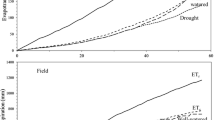Summary
Field experiments were conducted at two sites with differing root zone water holding capacities. Corn grain yield was measured as a function of water management treatments. Stress development in given treatments was generally limited to one of three periods (planting-to-12-leaf, 12-leaf-to-blister-kernel, and blister-kernel-to-physiologic-maturity) during the growing season. Stress levels were defined as low (L), moderate (M) or severe (S) and were based on degree of soil water depletion and an allowable level of leaf xylem pressure depression in midafternoon.
Yield vs seasonal ET exhibited linear relationships. Slope of an estimated upper bound function was 0.28 T/ha-cm of water use. Maximum seasonal grain yields were consistently produced with an L-L-L stress sequence allowing about 30–40% depletion of the root zone available water capacity (to 122 cm depth) between irrigations. A trickle irrigated treatment that maintained near zero soil water potential averaged about 4% more yield than the 30–40% depletion criteria, but this difference was not significant at P=0.05.
Results, when normalized as relative yield (Y/Ym) vs relative seasonal evapotranspiration (ET/ETm), indicated an upper bound slope of 1.50% yield loss per 1% decline in seasonal ET from the ETm level. When stress was concentrated in the 12 leaf to blister kernel period, the yield reduction slope was 2.60%.
Average observed Y/Ym ratios were 0.95 for M-L-L, 0.92 for S-L-L, 0.85 for L-M-L, 0.62 for L-S-L, 0.62 for L-S-L, 0.90 for L-L-M, and 0.69 L-L-S stress sequences.
If water stress is limited to one growth period per season an upper bound yield attainment is likely if irrigations relieve stress before available root zone storage capacity is 90–95% depleted in the planting to 12 leaf period, 80–90% depleted in 12 leaf to blister kernel period or when a programmed depletion to 100% available water exhaustion near physiological maturity is achieved in the later grain fill period.
Yield reduction of less than 5 % from potential levels appears likely in the climatic setting of this study when root zone available water depletions are limited to 60–70% in the early vegetative period (assumes near field capacity moisture at planting), 30–40% in the 12 leaf to blister kernel period, and 50–60% in the later grain fill period.
Similar content being viewed by others
References
Hagan RM, Stewart JI (1972) Water deficits — irrigation design and programming. J Irr Drain Div Am Soc Civil Eng 98 (IR2):215
Hanks RJ (1981, in press) Yield and water use relationships: In: Efficient Water Use in Crop Production. Taylor H, Jordon W (eds) Am Soc Agron Monogr Madison, WI
Hanks RJ, Ashcroft GL, Rasmussen VP, Wilson GD (1978) Corn production as influenced by irrigation and salinity -Utah Studies Irrig Sci 1:47
Hanks RJ, Keller J, Rasmussen VP, Wilson GD (1976) Line source sprinkler for continuous variable irrigation — crop production studies. Soil Sci Soc Am Proc 40:420
Jensen ME, Robb DCN, Franzoy GE (1970) Scheduling irrigation using crop-soil data. Proc Am Soc Civ Engr J Irrig Drain Div. 96 (IR1):25
Jensen ME, Haise HR (1963) Estimating evapotranspiration from solar radiation. Proc Am Soc Civ Engr, J Irrig Drain Div 89 (IR4):15
Maurer RE, Watts DG, Sullivan CY, Gilley JR (1979) Irrigation scheduling and drought-stress conditioning in corn. ASAE Paper No. 79–2509. St. Joseph, MI 49085.
Musick JT, Dusek DA (1978) Irrigated corn yield response to water. ASAE Paper No. 78–2552. St. Joseph, MI 49085
Ramirez JM (1972) The agro-climatology of North Dakota: Part 1/air temperature and growing degree days. Ext Bul No 15. N Dak Agr. Expt Sta, 30 p.
Retta A, Hanks RJ (1980) Corn and alfalfa production as influenced by limited irrigation. Irrig Sci 1:135
Scholander PF, Hammel HT, Brandstreet ED, Henningsen EA (1965) Sap pressure in vascular plants. Science (New York) 148:339
Skogerboe GW, Barrett JW, Treat BJ, McWhorter DB (1979) Potential effects of irrigation practices on crop yields in Grand Valley. Environ Prot Agency Tech Ser Ref 600/2-79-149, 139p.
Stegman EC, Musick JT, Stewart JI (1980) Irrigation water management. In: Design and operation of farm irrigation systems. M E Jensen (ed). Am Soc Agr Engr Monograph, St. Joseph, MI 49085
Stegman EC, Schiele LH, Bauer A (1976) Plant water stress criteria for irrigation scheduling. ASAE Trans 19 (5):850
Stewart JI, Danielson RE, Hanks RJ, Jackson EB, Hagan RM, Pruitt WO, Franklin WT, Riley JP (1977) Optimizing crop production through control of water and salinity levels in the soil. Utah Water Lab. PRWG 151-1. 191 p, Logan, Utah.
Stewart JI, Misra RD, Pruitt WO, Hagan RM (1975) Irrigating corn and grain sorghum with a deficit water supply. Trans Am Soc Agr Engr 18:270
Author information
Authors and Affiliations
Additional information
This work was supported by North Dakota Agricultural Experiment Station Projects 1432 and 1435 and by funds provided by the U.S. Department of Interior, Water and Power Resources Service
Rights and permissions
About this article
Cite this article
Stegman, E.C. Corn grain yield as influenced by timing of evapotranspiration deficits. Irrig Sci 3, 75–87 (1982). https://doi.org/10.1007/BF00264851
Received:
Issue Date:
DOI: https://doi.org/10.1007/BF00264851




